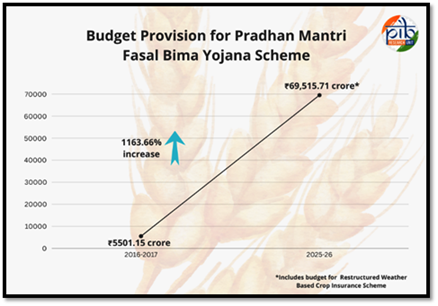Published on Feb 18, 2025
Daily PIB Summaries
PIB Summaries 18 February 2025

Content:
- Pradhan Mantri Fasal Bima Yojana turns Nine
- Pradhan Mantri Annadata Aay Sanrakshan Abhiyan (PM-AASHA) Scheme
Pradhan Mantri Fasal Bima Yojana turns Nine
Launch & Background
- PMFBY launched in 2016 .
- Celebrating 9 years of empowering farmers with crop loss protection from natural hazards.
- Aims to stabilize farmers’ income and encourage innovative practices.
Relevance : GS 2(Schemes ),GS 3(Agriculture )
Budget & Continuation
- Scheme’s continuation approved by Union Cabinet in January 2025 until 2025-26.
- Total budget allocation: ₹69,515.71 crore.
- Includes Restructured Weather Based Crop Insurance Scheme (RWBCIS) for weather-based risk coverage.
Technological Integration
- Uses satellite imagery, drones, UAVs, and remote sensing for various purposes.
- Enhanced loss assessment, yield estimation, and timely claims.
- YES-TECH (Yield Estimation System) introduced in Kharif 2023 to blend technology and manual systems for yield loss and insurance claims.

Key Benefits
- Affordable Premiums:
- Kharif crops: Max 2%, Rabi crops: Max 1.5%, Horticultural crops: Max 5%.
- Remaining premium subsidized by the government.
- Comprehensive Coverage: Includes natural disasters, pests, diseases, and post-harvest losses.
- Timely Compensation: Aims to process claims within 2 months of harvest.
- Technology-Driven Implementation: Uses advanced tech for accurate crop loss estimation and efficient claim settlement.
Risks Covered
- Yield Losses: Coverage for losses due to natural calamities (storms, floods, pests, etc.).
- Prevented Sowing: Coverage up to 25% of sum insured for farmers unable to sow due to weather.
- Post-Harvest Losses: Coverage for losses within 14 days post-harvest.
- Localised Calamities: Coverage for localized risks like hailstorms and landslides.
Improvements & Strengthening
- Increased transparency and accountability.
- Significant increase in coverage area and farmer participation.
- Scheme now the largest in the world for farmer applications.
- Some states waived off farmer’s premium share to reduce burden.
Eligibility & Popularity
- Voluntary for farmers, but non–loanee farmers make up 55% of coverage (2023-24).
- High voluntary participation highlights trust in the scheme.
Conclusion
- PMFBY has transformed agriculture by offering farmers protection against crop loss.
- Integrates modern technology for better assessment and claim settlement.
- Affordable premiums, broad risk coverage, and timely compensation support farmers’ livelihoods.
- Growing voluntary participation, especially among non-loanee farmers, showcases increasing trust in the scheme.
Pradhan Mantri Annadata Aay Sanrakshan Abhiyan (PM-AASHA) Scheme
Approval & Scheme Continuation
- Government approves the continuation of the Pradhan Mantri Annadata Aay Sanrakshan Abhiyan (PM-AASHA) scheme until 2025-26 under the 15th Finance Commission cycle.
- PM-AASHA aims to ensure remunerative prices for farmers and control price volatility of essential commodities.
- The Price Support Scheme (PSS) is part of PM-AASHA and involves procurement of pulses, oilseeds, and copra at the Minimum Support Price (MSP) by Central Nodal Agencies (CNAs), from pre-registered farmers through state-level agencies.
Relevance : GS 2(Schemes )
Targeted Crops & Procurement
- The government has decided to procure 100% of the Tur, Urad, and Masur production in the 2024-25 season under the PSS.
- This is intended to boost domestic production, reduce dependence on imports, and ensure better income for pulse farmers.
- The procurement process will continue for four years, as announced in the Budget 2025, to ensure self-sufficiency in pulses in India.
Procurement in 9 States for Kharif 2024-25 Season
- States involved: Andhra Pradesh, Chhattisgarh, Gujarat, Haryana, Karnataka, Madhya Pradesh, Maharashtra, Telangana, Uttar Pradesh.
- Total procurement target: 13.22 LMT (Lakh Metric Tons) for Tur (Arhar) in these states.
- Procurement already started in Andhra Pradesh, Karnataka, Maharashtra, and Telangana for the Kharif 2024-25 season.
Impact on Farmers
- 0.15 LMT of Tur has already been procured from 12,006 farmers across the four states mentioned.
- The scheme ensures that 100% of the Tur produced by farmers will be bought by the government through NAFED (National Agricultural Cooperative Marketing Federation) and NCCF (National Cooperative Consumers’ Federation).
- The procurement aims to support farmers by offering remunerative prices, reducing market risks, and preventing exploitation by intermediaries.
Policy Objectives
- Incentivizing farmers: Encourages increased domestic pulse production to achieve self-sufficiency.
- Reducing reliance on imports: Ensures the country is less dependent on imported pulses by strengthening domestic supply chains.
- Price stability: Helps stabilize the prices of pulses in the market, ensuring affordability for consumers and fair prices for farmers.
Future Outlook
- The scheme will continue for four more years, maintaining the government’s commitment to purchasing 100% of the production of these pulses from farmers, thus enhancing their incomes.
- The goal is to achieve self-sufficiency in pulses by boosting production and procurement across the country, thus reducing the dependency on international markets and stabilizing domestic prices.
